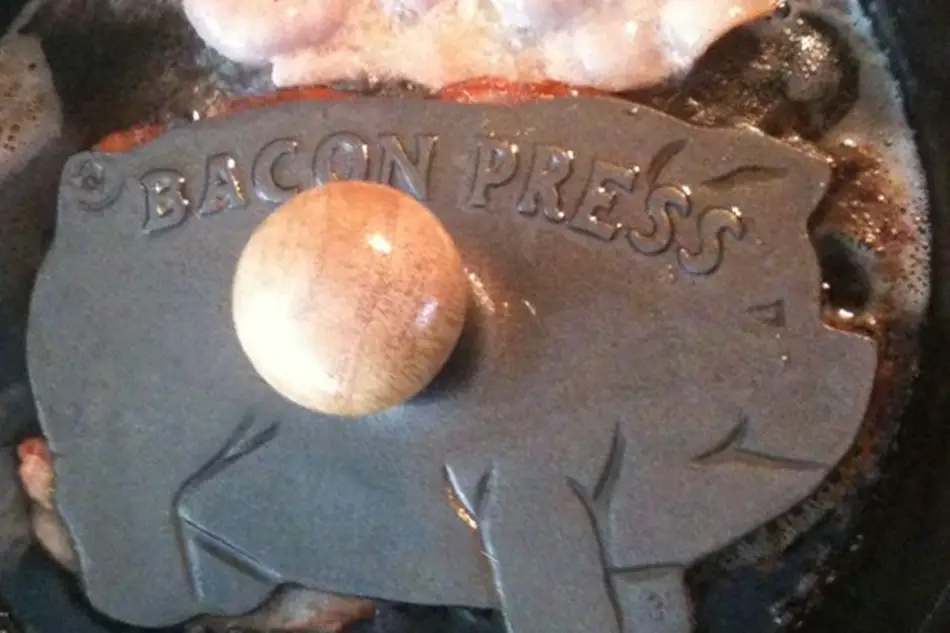Bacon is a staple breakfast item in America. If you go to a diner, you will get two perfectly flat, crispy pieces of bacon alongside the rest of your breakfast. How does the bacon get that perfect?! They use a bacon press!
The purpose of a bacon press is to prevent the bacon from curling, decrease cooking time, and promote even cooking while it is frying. Placing the heavy press (usually made of cast iron) on top of the bacon while it fries keeps the bacon flat. The surface conducts heat, decreasing cooking time while improving even cooking.
So now we know why to use a bacon press, but what exactly is it, and how do we choose the best one?
What Is A Bacon Press?
I wouldn’t say that bacon presses are common knowledge. You now know the purpose of a bacon press, but what is the actual physical object? What is a bacon press?
A bacon press is a heavy, flat object placed on top of the bacon as it is cooking to prevent it from curling or shriveling. Bacon presses are typically made out of cast iron but may be made of aluminum, stainless steel, or glass. Their shape may be rectangular, circular, or novelty (like pig-shaped).
If you would like to know how to use a bacon press, check out my article How Do You Cook Bacon On A Press? How Do You Use A Bacon Press?
Continue reading to learn more about which may be best for you! If this is your first time learning about bacon presses, there are a lot more options than you might have guessed.
What Is The Best Bacon Press?
For most people, the best bacon press is made of cast iron. Cast Iron bacon presses are both durable and relatively inexpensive. They speed up the cooking process, and the weight provides optimal compression of your food.
The Bellemain Cast Iron Grill Press is my recommendation for round, and the Victoria Cast Iron Bacon Press is best for rectangle. These options both have wooden handles that will stay cool and protect your hands.
There are two main things to consider when you are picking a bacon press: shape and material. Below I will go over the features of each so that you can decide which is best for you. Though cast iron is the most common and most highly recommended, you may decide that some of the other features are more favorable for YOU!
At the end of each section, I will provide recommendations for each option for your convenience! These link will all be Amazon affiliate links.
Bacon Press Shapes
Rectangular
If you use a griddle or a square/rectangle skillet, you would probably prefer a rectangular bacon press. There are a variety of sizes, from about 6 by 4 inches to 9 by 5.5 inches.
Round
A round bacon press is better if you are using a round skillet. You will need to ensure the size of press you buy will fit inside the bottom of your skillet. Skillet size is measured by the top rim, not the base, which typically is slightly smaller than the top, so make sure you pay attention to what you are buying.
Novelty
Novelty shaped bacon presses are usually pig-shaped. These are functional bacon presses, but add a decorative element if you want to leave it out. They are usually more rectangular, so if you plan to use is a round skillet, just double check your dimensions. If you want something decorative and like pigs, go for it!
Bacon Press Material
There are a few qualities that I will discuss for each material choice. Let’s look at those qualities and how they may impact your choice.
- Durability
Some materials are more prone to damage than others. If you are looking for a long-term investment, you will likely want a more durable product. - Affordability
Cost is important. Some bacon presses are more expensive than others. - Conductivity
All of the materials used will conduct heat. Some will heat up faster; some will hold heat longer. These features may impact your choice based on personal preference. - Weight
Weight is another feature that doesn’t have a “right” option. In terms of use for bacon, they will all work well. It does not take a lot of weight to keep bacon flat.
This being said, bacon presses (also called grill presses) can be used to make paninis, quesadillas, hamburgers, or steaks. For these tasks, you may prefer a lighter or heavier option.
Do you like to press out a lot of the fat from your burgers or steaks? You may prefer a heavier option. Do you want to keep most/all of the juices in your meat? You would like a lighter option. Do you like flatter sandwiches? Go heavy….You get the picture. - Maintenance
Some materials are more complicated to take care of than others. This quality very well may impact your choice.
Cast Iron
- Cast iron is the most common option for bacon presses. It is the most durable material used.
- Cast iron bacon presses are relatively inexpensive, though not the cheapest option when it comes to bacon presses. The combo of durability and affordability is lucrative.
- Cast iron heat somewhat “slowly,” but once pre-heated, it will retain heat for a long time. This will speed up the cooking process by about a third usually.
- Bacon presses made of cast iron are heavy, typically 2-3 pounds.
- Cast iron requires some work to maintain. You will have to season it and ensure it stays rust-free. It is not dishwasher safe.
Recommendations: The Bellemain Cast Iron Grill Press is my recommendation for round, and the Victoria Cast Iron Bacon Press is best for rectangle.
Stainless steel
Stainless steel is an alternative to cast iron if you are not good about keeping cast iron seasoned.
- Stainless steel bacon presses are moderately durable.
- These are the most expensive option in terms of material for bacon presses.
- Stainless steel bacon presses typically heat up and “lose” heat quickly, therefore not significantly reducing cooking time.
- Bacon presses made of stainless steel are usually heavier than cast iron, typically 3-3.5 pounds. I did find some options that were less than two pounds if you are looking for lighter.
- Stainless steel requires moderate maintenance. The bacon press options I found are NOT dishwasher safe but can be washed by hand.
Recommendations: For round stainless steel, this is my recommendation; and for rectangular, this one from the same brand is excellent.
Aluminum
- Aluminum bacon presses are also moderately durable. They should last you a long time.
- Aluminum is the least expensive option when it comes to bacon presses.
- Aluminum heats very quickly but also cools off very quickly. So similar to the stainless steel option, it may not speed the cooking process as much as cast iron.
- Aluminum is very lightweight, and bacon presses made of this metal are generally around one pound.
- Aluminum requires moderate maintenance, as it can be hand-washed but is not dishwasher safe. You should also not use something abrasive such as a grill brush on the surface.
Recommendations: Aluminum bacon presses are typically rectangular. I did not find round, though I’m sure they do exist somewhere. For the rectangular option, this is my recommendation.
Glass
- Glass bacon presses are very durable, as long as you don’t drop them!
- They are not super expensive, but they are tough to find. (I found ONE option on Amazon, and it didn’t have awesome reviews). Generally, these are a more vintage item, and you may score on a thrifting trip! (Side note-I LOVE thrift stores!)
- Glass heats up somewhat slowly but retains heat very well, which will make the cooking process faster.
- Glass presses can vary in weight. Newer ones are lighter, coming in around a pound, but if you find a vintage glass press, it will be made of heavier glass.
- Glass is easy to maintain. This is the ONLY dishwasher-safe option when it comes to bacon presses.
Recommendations: Glass bacon presses are hard to find. This is the only decent one I could find commercially. (Links to HarrietCarter.com)
Really though, I recommend keeping an eye out at your local thrift stores for a vintage one. It will likely be better quality, last you longer, and be heavier.
Related Content: Where Does Bacon Come From? What Part of The Pig?
Bacon Press for Non-stick Pans
Because non-stick pans are easily damaged or scratched, you should find a glass bacon press. Metal bacon presses are more prone to cause damage to your non-stick pans.
Here (Links to HarrietCarter.com) is a glass bacon press with decent reviews, but your best option is to search around some local thrift stores for a truly vintage option. These will be higher quality and more durable.
Bacon Press Alternatives
If you don’t have a bacon press, you can use a small cast iron pan or a wire rack as an alternative. A cast iron pan will give you the weight of a typical cast iron bacon press and speed the frying process by holding heat. A wire rack will help prevent the bacon from curling but not speed up the cooking process like a cast iron option.
Homemade Bacon Press
If you are looking for a DIY option for a bacon press, you can make a homemade bacon press by wrapping a small brick in aluminum foil. You can then place this on the bacon while it cooks to prevent curling and help the bacon cook evenly.
More Bacon Information
I’ve written a lot of information about bacon. If you are interested in seeing all my bacon-related articles, click here.

